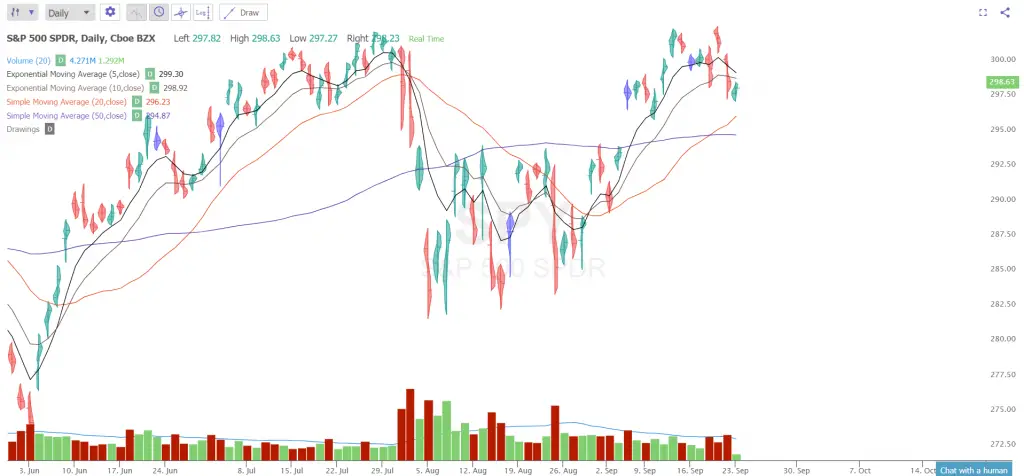While modern traders are spoiled( 약탈되다)with the ease we have of seeing moving averages on our charting platforms in an instant, older traders had to calculate them for their self and update their own charts by hand drawing them daily before the days of better computing power and software. Many believe this gave them a better feel for price action and trends if they were discretionary traders.
현대의 무역업자들은 우리가 우리의 차트 작성 플랫폼에서 움직이는 평균을 순식간에 볼 수 있는 손쉬운 것에 만족하지만, 나이든 거래자들은 더 나은 계산 능력과 소프트웨어가 있는 날 이전에 매일 손으로 그려서 그들 자신의 차트를 갱신해야 했다. 많은 사람들은 이것이 그들이 자유 무역업자라면 가격 행동과 추세에 대해 더 나은 느낌을 주었다고 믿는다.
In this post I am going to review how the calculation of a moving average is done so readers understand more deeply how this technical indicator is created and why the this line on our chart moves as price moves based on its time frame based on whether we are using a simple of exponential moving average. I believe it is good to understand how how technical indicators work.
In technical trading a simple moving average (SMA) is the unweighted average of the previous price data of the time frame it is defining. The simple moving average is calculated by adding up prices over the specified period being measured and dividing the total by the number of periods in the SMA.
이 게시물에서 나는 독자가 이 기술 지표가 생성되는 방법을 더 깊이 이해하고 왜 우리의 차트에이 라인이 우리가 간단한을 사용하고 있는지 여부에 따라 시간 프레임에 따라 가격이 이동으로 이동하는 이유를 더 깊이 이해할 수 있도록 이동 평균의 계산이 수행되는 방법을 검토할 것입니다
지수 이동 평균의. 나는 기술 지표가 어떻게 작동하는지 이해하는 것이 좋다고 생각합니다.
기술 거래에서 간단한 이동 평균(SMA)은 정의하는 시간 프레임의 이전 가격 데이터의 가중치가 없는 평균입니다. 단순 이동 평균은 측정되는 지정된 기간 동안의 가격을 합산하고 총값을 SMA의 기간 수로 나누어 계산됩니다.
A moving average is calculated by adding up all the prices in the time frame you want the moving average for then dividing the total by the time frame period. The average of prices changes each time new data is added and the oldest data is removed from the calculation causing it to move. 이동 평균은 이동 평균을 원하는 시간 프레임에 모든 가격을 합한 다음 총계를 시간 프레임 기간으로 나누어 계산합니다. 새 데이터가 추가되고 계산에서 변화를 일으키는 원인이 되는 가장 오래된 데이터가 제거 될 때마다 평균 가격이 변경됩니다.
Example of how to calculate a 5 day simple moving average:
5 일 단순 이동 평균을 계산하는 방법의 예
Daily Closing Prices: 11,12,13,14,15,16,17
First day of 5-day SMA: (11 + 12 + 13 + 14 + 15) / 5 = 13
Second day of 5-day SMA: (12 + 13 + 14 + 15 + 16) / 5 = 14
Third day of 5-day SMA: (13 + 14 + 15 + 16 + 17) / 5 = 15
일일 종가: 11,12,13,14,15,16,17
5일 SMA의 첫날: (11 + 12 + 13 + 14 + 15) / 5 = 13
5일 SMA 둘째 날: (12 + 13 + 14 + 15 + 16) / 5 = 14
5일 SMA의 셋째 날: (13 + 14 + 15 + 16 + 17) / 5 = 15
An exponential moving average (EMA) tries to create a faster signal by reducing the time it takes to move by giving more weight to the newest prices in the formula. The magnitude of weighting that is applied to the more recent price data is dependent on the amount of time periods in the exponential moving average. EMAs are different from SMAs because each day’s EMA calculation is dependent on the EMA calculations for the days before that day. Due to the weighting difference of current data over past data you will need more than 10 days of data to calculate an accurate 10 day EMA.
지수 이동 평균(EMA)은 이 공식의 최신 가격에 더 많은 비중을 두어 이동하는 데 걸리는 시간을 줄임으로써 더 빠른 신호를 생성하려고 한다. 보다 최근의 가격 데이터에 적용되는 가중치의 크기는 지수 이동 평균의 기간 양에 따라 달라진다. EMA는 매일 EMA 계산이 전날의 EMA 계산에 의존하기 때문에 SMA와 다르다. 과거 데이터에 대한 현재 데이터의 가중치 차이 때문에 정확한 10일 EMA를 계산하려면 10일 이상의 데이터가 필요하다.
Initial SMA: 10-period sum / 10
Multiplier: (2 / (Time periods + 1) ) = (2 / (10 + 1) ) = 0.1818 (18.18%)
EMA: {Close – EMA(previous day)} x multiplier + EMA(previous day).
초기 SMA: 10주기 합계 / 10 A 10 day exponential moving average applies an 18.18% weighting to the most recent price. A 20 day EMA applies a 9.52% weighting to the most recent price data (2/(20+1) = .0952). The weighting for shorter time frames are more than the weighting for the longer time frames. The weighting is reduced by half every time a moving average time frame doubles.
곱하기: (시간 + 1) = (2 / (10 + 1) = 0.118 (18.18%)
EMA: {닫기 – EMA(이전날)} x 곱셈 + EMA(이전날).
10 일 지수 이동 평균은 가장 최근 가격에 18.18 % 가중치를 적용합니다. 20 일 EMA는 가장 최근 가격 데이터 (2 / (20 + 1) = .0952)에 9.52 % 가중치를 적용합니다. 짧은 시간 프레임에 대한 가중치는 더 긴 시간 프레임에 대한 가중치보다 큽니다. 이동 평균 시간 프레임이 두 배가 될 때마다 가중치가 절반으로 줄어 듭니다.
EMA에 특정 비율을 사용하려는 경우이 수식을 사용하여 기간으로 변환 한 다음 해당 값을 EMA의 매개 변수로 입력 할 수 있습니다.
If you want to use a specific percentage for an EMA, you can use this formula to convert it to time periods and then enter that value as the EMA’s parameter:
Time Period = (2 / Percentage) – 1
3% Example: Time Period = (2 / 0.03) – 1 = 65.67 time periods
For a deeper dive on how to trade with moving averages check out my book Moving Averages 101.

Chart courtesy of TrendSpider.com